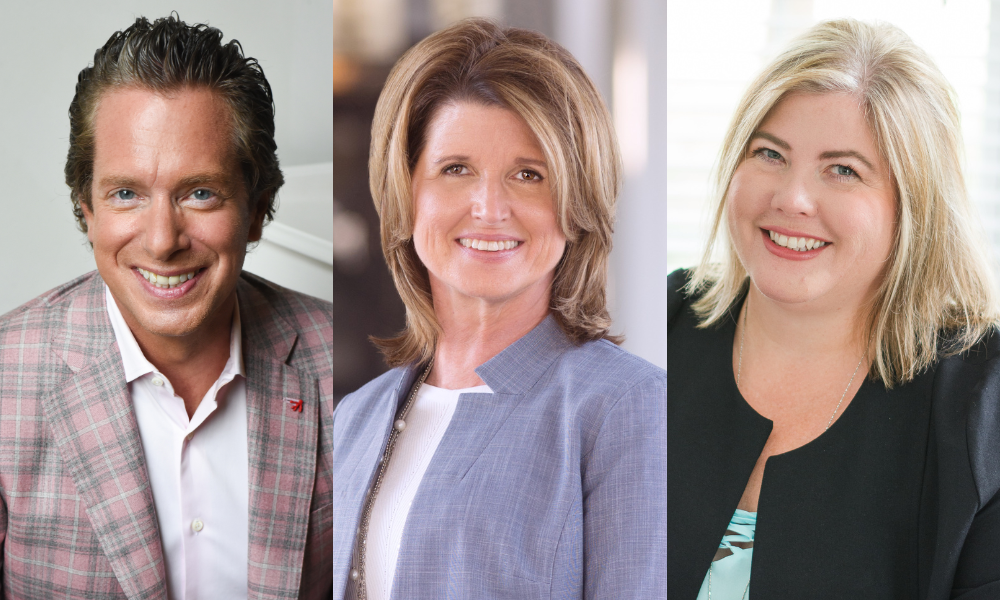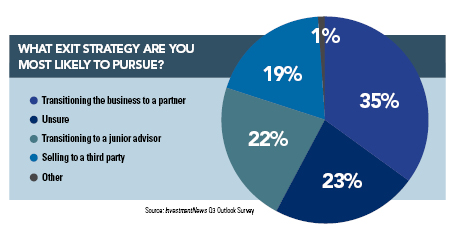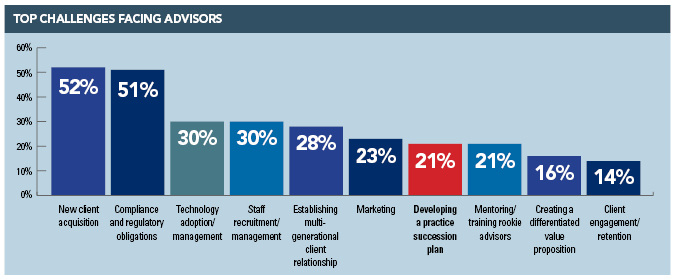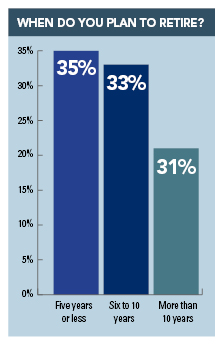

With due deference to both Sly and the Family Stone, simply making something a family affair doesn’t make it any easier.
When it comes to passing down a financial advisory practice, for instance, sometimes keeping it in the family makes it tougher – that is, unless there is a tremendous amount of communication and work done upfront to make the transition work. And even then, it might not end up being hot fun in the summertime.
How does InvestmentNews know that’s the case? Well, we asked everyday people of course!
When it came to transitioning his business to his children, Michael Goldstein, financial advisor with Prudential Advisors, made it a prerequisite that they work with him well beforehand. His daughter started working part-time in the practice as a teenager, while his son Brandon worked with him while in high school.
Before they could take over the business, they had to show their commitment by getting licensed and proving their readiness, according to Michael.
“We didn’t just rely on existing clients; Brandon learned the hard way,” said Michael. “We taught him how to pursue new opportunities. We decided to focus on acquiring new clients right from the beginning, rather than relying on existing ones.”
Making sure the firm’s clients were comfortable with the eventual change of control was also paramount for the pair. That’s why Michael would personally introduce Brandon every time he sat in on an appointment. They even made brochures with both their pictures and handed them out to clients.
“Some clients initially expressed concern, saying they preferred to deal only with me. But I was honest and told them they would eventually need to trust Brandon,” said Michael.
Michael also had to gain the trust of another very important group before turning the reins over to Brandon – the rest of the Goldstein family.
“As a family, we agreed that the original value of the business, before Brandon took over, was to be divided equally among my three children. I took the value of the business at the time and set up a plan. One avenue is through life insurance to ensure an equitable distribution. This way, it was clear to my other two kids what the commitment was,” said Michael, who worked with a lawyer to set up the documents.
In that transition plan, Michael chose a specific time for the transition, but says he is open to adjusting the timeline if his son needs additional guidance. His plan is to fully retire in a few years at age 70, which will have been over a decade since Brandon officially joined him in the practice.
“Some clients value the idea of a business being passed from parent to child, as it reflects the strength and stability of the business. This has helped us win over several clients who appreciated that continuity,” said Michael.
Here’s an anecdote from Mercer Advisors about a father-daughter succession plan that ended up in a sale to an outside party, yet still had a happy ending.
Michael Duckworth founded Duckworth Wealth Advisors in 1998. His daughter, Kara Duckworth, joined her father soon after he started the business. Along with two other long-time staff members, she became a minority owner in the company. From a succession planning perspective, they were all working toward running the business when Michael retired.
As they got deeper into that succession planning process, however, the internal option increasingly wasn't proving to be the right solution.
“We did a lot of soul-searching for what we wanted not only for our clients, but also for our careers,” said Kara Duckworth, managing director of client experience at Mercer Advisors. “We were already wearing multiple hats and performing duties that took us away from what we enjoyed doing, which is working with our clients.”
As they explored the internal path further, they understood they would have to shoulder even more business management responsibilities, further limiting their time with clients.
“Ultimately, we decided that joining a partner with more resources and support teams that would allow us to focus on clients was what we wanted to pursue,” said Kara Duckworth.
After much due diligence, the team joined Mercer Advisors in 2017. “It was a little bittersweet to lose the Duckworth name when we joined. However, we have no regrets about doing the right thing for our clients and for our careers.”

For Jennifer Strojny Milligan, financial planner at Strojny Financial Services, it’s all about control.
“In coaching advisors, I feel the real challenge is making sure the child is ready to take over,” said Milligan. “The parent advisor is often reluctant to let go of enough control to really allow the successor advisor to step into the client relationships in a way where the client views them as an equal instead of a subordinate.”
In Milligan’s firm, this was accomplished over a period of nine years. She spent the first three years in meetings as an assistant, taking notes and handling follow-up. The next three years, she was in the meeting to make at least one recommendation or presentation. And then for the final three years, she ran the meetings, while her father was there for small talk and color commentary.
“This can obviously be shortened, but you want the successor to be leading meetings for a while before the parent advisor is ready to step out,” said Milligan.
While Milligan’s parents still work at the firm, all the managerial responsibilities have transitioned to her. And together, the family agreed to an eventual sale price that would maximize the value to her parents without putting Milligan and the firm behind the eight-ball. It helped that they had a great deal of trust and a long runway.
“I took a lower pay rate – although definitely an adequate one – than an outside party would have been paid to do the same job. That allowed my parents to fund annuities for their future retirement pay with the funds that would have been paid to someone who wasn’t a successor. That avoided a huge financing problem for me at the time of transition, and my parents could have a guaranteed income for life through their annuities,” said Milligan.
Mark Pearson is the founder and CEO at Nepsis. His son Matt is the president of the firm, and has been watching his dad in the office since he was five years old.
“Engaging them in the firm as early as possible allows you to mentor and assess the progress of the child working in the firm,” said Mark.
Leaving the firm to a son or daughter takes time – and planning – as well, according to Mark.
“The process starts with tax planning and affects your entire estate and associated taxes. The first step is knowing your family financial goals and potential tax implications in leaving a practice to your children,” said Mark. “Tax and estate planning are critical aspects of maximizing value and minimizing debt and taxes.”
Added Mark, “While I have no plans to ever retire, my focus was and has been on making 100 percent sure the firm could continue if I were gone.”
Mark Dutram, president of BayView Private Wealth, welcomed his son Chandler into his business last year after Chandler spent a few years establishing himself elsewhere as a financial advisor. As to how this might affect the balance of an ongoing concern, Mark believes it’s up to the child to prove him- or herself.
“Your son or daughter must earn it by way of capacity, experience, credentials, time with clients, and time with the team demonstrating their ability, leadership skills, and likeability. This will ensure they are ready and confident enough to assume the role, and that clients and staff have already built a trusting relationship that will help facilitate a smooth transition,” said Mark.
As to the deal itself, Dutram believes the parent should be confident enough to hold the financing for their son or daughter to allow them to buy the practice without the use of outside financing and additional interest expenses. There are some obvious tax benefits for the owner, but this will also convey the trust you have in the plan for the next generation to succeed.
“Owner financing is certainly not the only way to facilitate the transaction, but this structure should have helped you make sure that you have maximized the value and minimized the uncertainty with regard to the dependability of the future payout expected,” said Mark.
Finally, Jim and Kelley Tate, partners at Green Fairways Wealth Management, part of Stifel Independent Advisors – and parents of Green Fairways employees Jake (advisor) and Alex (client associate) Tate – believe that before a parent even begins thinking about passing down their firm to their children, they need to check with one very important set of clients first.
“First and foremost, make absolutely sure that this is what they want, and it is not because you want it for them,” said Jake and Alex's mom and dad.


Relationships are key to our business but advisors are often slow to engage in specific activities designed to foster them.

Whichever path you go down, act now while you're still in control.

Pro-bitcoin professionals, however, say the cryptocurrency has ushered in change.

“LPL has evolved significantly over the last decade and still wants to scale up,” says one industry executive.

Survey findings from the Nationwide Retirement Institute offers pearls of planning wisdom from 60- to 65-year-olds, as well as insights into concerns.
Streamline your outreach with Aidentified's AI-driven solutions
This season’s market volatility: Positioning for rate relief, income growth and the AI rebound
